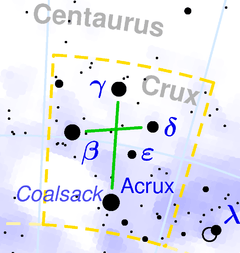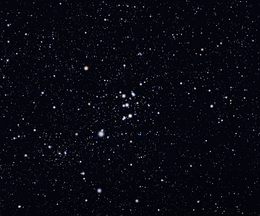HD 110432
HD 110432 is a Be star in the south-east of Crux, behind the center of the southern hemisphere's dark Coalsack Nebula. It has a stellar classification of B1IVe, which means it is a subgiant star of class B that displays emission lines in its spectrum. This is a variable star of the Gamma Cassiopeiae type, indicating it is a shell star with a circumstellar disk of gas about the equator, and has the variable star designation BZ Crucis. It is not known to be a member of a binary system, although it is probably a member of the open cluster NGC 4609. This star is moderately luminous in the X-ray band, with a variable energy emission of 1032–33 erg s−1 in the range 0.2−12 keV. The X-ray emission may be caused by magnetic activity, or possibly by accretion onto a white dwarf companion.[3]
 | |
| Observation data Epoch J2000 Equinox J2000 | |
|---|---|
| Constellation | Crux |
| Right ascension | 12h 42m 50.2656s[1] |
| Declination | −63° 03′ 31.048″[1] |
| Apparent magnitude (V) | 5.24 - 5.45[2] |
| Characteristics | |
| Spectral type | B1IVe[3] |
| U−B color index | −0.82[4] |
| B−V color index | +0.27[4] |
| Variable type | γ Cas[2] |
| Astrometry | |
| Radial velocity (Rv) | +35[5] km/s |
| Proper motion (μ) | RA: −12.512[1] mas/yr Dec.: −3.984[1] mas/yr |
| Parallax (π) | 2.3834 ± 0.1228[1] mas |
| Distance | 1,370 ± 70 ly (420 ± 20 pc) |
| Absolute magnitude (MV) | −2.56[6] |
| Details | |
| Mass | 9.6[3] M☉ |
| Radius | 6.5±1.2[7] R☉ |
| Luminosity | 1,153[1] L☉ |
| Surface gravity (log g) | 3.5–3.9[3] cgs |
| Temperature | 22,510–25,000[3] K |
| Rotational velocity (v sin i) | 300–400[3] km/s |
| Other designations | |
| Database references | |
| SIMBAD | data |

Distance
The distance of 388 pc published in the 2007 new Hipparcos reduction is over twice the distance of the Coalsack Nebula.[9] The distance from Gaia Data Release 2 is even further at 420 pc.[1]
References
- Brown, A. G. A.; et al. (Gaia collaboration) (August 2018). "Gaia Data Release 2: Summary of the contents and survey properties". Astronomy & Astrophysics. 616. A1. arXiv:1804.09365. Bibcode:2018A&A...616A...1G. doi:10.1051/0004-6361/201833051. Gaia DR2 record for this source at VizieR.
- Samus, N. N.; Durlevich, O. V.; et al. (2009). "VizieR Online Data Catalog: General Catalogue of Variable Stars (Samus+ 2007-2013)". VizieR On-line Data Catalog: B/GCVS. Originally Published in: 2009yCat....102025S. 1: B/gcvs. Bibcode:2009yCat....102025S.
- Lopes de Oliveira, R.; et al. (November 2007). "On the X-ray and optical properties of the Be star HD 110432: a very hard-thermal X-ray emitter". Astronomy and Astrophysics. 474 (3): 983–996. arXiv:astro-ph/0701767. Bibcode:2007A&A...474..983L. doi:10.1051/0004-6361:20077295.
- Cousins, A. W. J. (1973). "UBV photometry of some southern stars". Monthly Notes of the Astronomical Society of Southern Africa. 32: 11. Bibcode:1973MNSSA..32...11C.
- Evans, D. S. (June 20–24, 1966). "The Revision of the General Catalogue of Radial Velocities". In Batten, Alan Henry; Heard, John Frederick (eds.). Determination of Radial Velocities and their Applications, Proceedings from IAU Symposium no. 30. University of Toronto: International Astronomical Union. Bibcode:1967IAUS...30...57E.
- Anderson, E.; Francis, Ch. (2012). "XHIP: An extended hipparcos compilation". Astronomy Letters. 38 (5): 331. arXiv:1108.4971. Bibcode:2012AstL...38..331A. doi:10.1134/S1063773712050015.
- Stee, Ph; Meilland, A.; Bendjoya, Ph.; Millour, F.; Smith, M.; Spang, A.; Duvert, G.; Hofmann, K. -H.; Massi, F. (2013). "Evidence of an asymmetrical Keplerian disk in the Brγ and He I emission lines around the be star HD 110432". Astronomy and Astrophysics. 550: A65. arXiv:1301.2877. Bibcode:2013A&A...550A..65S. doi:10.1051/0004-6361/201220302.
- "HR 4830 -- Be Star". SIMBAD. Centre de Données astronomiques de Strasbourg. Retrieved 2010-12-09.
- Van Leeuwen, F. (2007). "Validation of the new Hipparcos reduction". Astronomy and Astrophysics. 474 (2): 653. arXiv:0708.1752. Bibcode:2007A&A...474..653V. doi:10.1051/0004-6361:20078357.